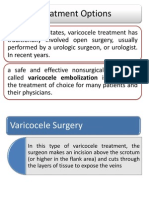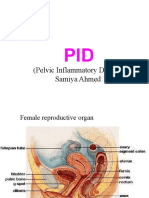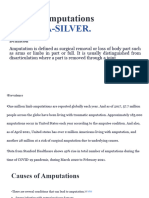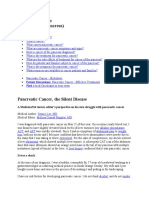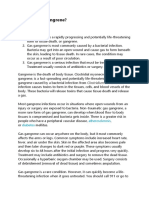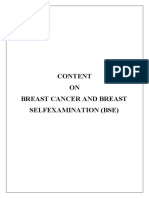50%(2)50% found this document useful (2 votes)
163 viewsThe Breast: Anatomy
The Breast: Anatomy
Uploaded by
Ryan James Lorenzo MiguelThe document summarizes the anatomy and common disorders of the breast. It describes the lobes, ducts, and other structures that make up the breast. Common breast masses originate from the terminal ducts or lobules. The most common presenting symptoms of breast disease are pain, palpable masses or lumps, and nipple discharge. Common benign and malignant breast tumors are discussed, along with risk factors, classifications, prognostic factors, and stromal tumors.
Copyright:
© All Rights Reserved
Available Formats
Download as PDF, TXT or read online from Scribd
The Breast: Anatomy
The Breast: Anatomy
Uploaded by
Ryan James Lorenzo Miguel50%(2)50% found this document useful (2 votes)
163 views3 pagesThe document summarizes the anatomy and common disorders of the breast. It describes the lobes, ducts, and other structures that make up the breast. Common breast masses originate from the terminal ducts or lobules. The most common presenting symptoms of breast disease are pain, palpable masses or lumps, and nipple discharge. Common benign and malignant breast tumors are discussed, along with risk factors, classifications, prognostic factors, and stromal tumors.
Original Description:
Breast
Original Title
Breast
Copyright
© © All Rights Reserved
Available Formats
PDF, TXT or read online from Scribd
Share this document
Did you find this document useful?
Is this content inappropriate?
The document summarizes the anatomy and common disorders of the breast. It describes the lobes, ducts, and other structures that make up the breast. Common breast masses originate from the terminal ducts or lobules. The most common presenting symptoms of breast disease are pain, palpable masses or lumps, and nipple discharge. Common benign and malignant breast tumors are discussed, along with risk factors, classifications, prognostic factors, and stromal tumors.
Copyright:
© All Rights Reserved
Available Formats
Download as PDF, TXT or read online from Scribd
Download as pdf or txt
50%(2)50% found this document useful (2 votes)
163 views3 pagesThe Breast: Anatomy
The Breast: Anatomy
Uploaded by
Ryan James Lorenzo MiguelThe document summarizes the anatomy and common disorders of the breast. It describes the lobes, ducts, and other structures that make up the breast. Common breast masses originate from the terminal ducts or lobules. The most common presenting symptoms of breast disease are pain, palpable masses or lumps, and nipple discharge. Common benign and malignant breast tumors are discussed, along with risk factors, classifications, prognostic factors, and stromal tumors.
Copyright:
© All Rights Reserved
Available Formats
Download as PDF, TXT or read online from Scribd
Download as pdf or txt
You are on page 1of 3
THE BREAST
ANATOMY Pain (mastalgia or mastydonia)
Palpable mass (≥2cm in size)
Consists of 6-10 lobes o Most common
Keratinizing squamous epithelium- nipple and Invasive carcinomas
areola Fibroadenomas
Double-layered cuboidal epithelium- ducts Cysts
Colostrum – produced by luminal cells of the o Malignancy increases with age
lobules
Nipple discharge
Anatomic Origins of Common Breast Mass o Bloody discharge- MC in benign tumors
Terminal duct o Milky d/c – increase in Prl
o Lobular unit
Cyst Mammography - @ age 40
Scerosing Adenosis Densities and calcifications – principal signs of breast
Small duct papilloma cancer
Hyperplasia Densities – MC prod by
Atypical hyperplasia o Carcinoma
Carcinoma o Fibroadenoma
o Lobular duct o Cysts
Fibroadenoma Calcification – MC prod by
Phyllodes tumor o Apocrine cyst
o Large ducts and lactiferous sinuses o Hyalinized fibroadenoma
Duct ectasia o Sclerosing adenosis
Recurrent subareolar abcesses
Solitary ductal papilloma Inflammatory disorders
Paget disease
o Interlobular stroma Acute Mastitis-
Fat necrosis MC cause – S. aureus – single/multiple focal
Lipoma abscesses
Fibrous tumor S. epidermidis – diffuse abscess, involves the
Fibromatosis entire breast
Sarcoma Periductal Mastitis
Subareolar abscess, Zuska disease
DISORDERS OF DEVELOPMENT Associated with smoking
Non-proliferative Breast change (Fibrocystic
Milk line remnants- change)
o supernumerary nipples Cyst- blue dome cyst
Accessory Axillary Breast Tissue Fibrosis
o Ductal system extends to SC tissue of the chest Adenosis- inc # of acini/ lobule
wall or the axillary fossa Proliferative Breast Disease without atypia
Congenital Nipple Inversion Epithelial hyperplasia
o Correct spontaneously Sclerosing adenosis
o Acquired nipple retraction- may indicate Complex sclerosing lesion
presence of an invasive cancer or an Papillomas
inflammatory disorder Proliferative Breast Disease with Atypia
Associated with radiologic calcifications
CLINICAL PRESENTATION OF A BREAST DISEASE Cellular proliferation resembling carcinoma in
situ
Most common symptoms: Pain Atypical ductal hyperplasia
Palpable mass or Lumpiness Atypical lobular hyperplasia
Nipple discharge
Carcinoma in situ
Carcinoma of the Breast Ductal (DCIS)
Comedocarcinoma- high grade
MC non-skinmalignancy in women Cribriform DCIS – cookie cutter-like
Majority are ER-positive Solid DCIS
ER negative tumors – basal-like Papillary DCIS
HER2/neu positive – in young women Microcapillary DCIS- bulbous protrusions,
BRCA1 or BRCA2 – hereditary breast cancer gene arranged in complex intraductal patterns
Paget disease – maybe mistaken as
Risk Factors erythema, with palpable nodules and have
o Gender – most important RF underlying invasive carcinoma
o Age – peaks at age 75-80 DCIS with microinvasion- invasion through
o Age at menarche the basement membrane into the stroma
o Age at first live birth measuring no more than 0.1 cm
o First degree relatives with breast ca Treatment – MASTECTOMY
o Atypical hypeplasia
o Race/Ethnicity Lobular Carcinoma In Situ (LCIS)
o Estrogen Exposure Atypical lobular hyperplasia
o Breast Density Invasive lobular hyperplasia
o Radiation exposure
o Carcinoma of the contralateral breast or Mucin positive signet-ring cells are
endometrium commonly present
o Geographic influence
o Diet Invasive Carcinoma
o Obesity Associated with axillary lymph node metastases
o Exercise Peau d’ orange
o Breastfeeding
o Environmental toxin Invasive Carcinoma, No Special type (NST; Invasive
o Tobacco Ductal Carcinoma)
Majority of Carcinomas
Etiology and Pathogenesis
Major RF for the development of breast cancer are
Invasive Lobular Carcinoma
Hormonal and Genetic
Dyscohesive infiltrating tumor cells
Signet ring cells containing mucin droplets
Hereditary Breast CA
o Mutations in BRCA1 and BRCA2
Medullary Carcinoma
o BRCA1 – assoc with ovarian ca
Sporadic Breast CA Soft, fleshy, and well circumscribed tumor
o Major RF for sporadic breast ca are related to Poorly differentiated
hormone exposure Better prognosis than NST carcinomas
o Hormonal exposure- inc the num of potential Mucinous (Colloid) Carcinoma
target cells by stimulating breast growth during Tumor is soft and rubbery
puberty Appears like pale gray-blue gelatin
o Estrogen- play direct role in carcinogenesis
Tubular Carcinoma
Classification of Breast Carcinoma Consist exclusively of well-formed tubules and
MC malignancies are ADENOCARCINOMAS, divided into are sometimes mistaken for benign sclerosing
in situ carcinomas and invasive carcinoma lesions.
Excellent prognosi
Carcinoma In situ- limited to ducts and lobules by the
basement membrane Invasive Papillary Carcinoma
Invasive ca- infiltrating ca, has penetrated to the stroma ER positive,
Have favourable prognosis
Metaplastic Carcinoma
Includes rare types of breast cancer
Prognosis are generally poor
Prognostic and Predictive Factors
Distant metastases – once present, cure is unlikely
Lymph node metastases – most important
prognostic factor for invasive carcinoma in the
absence of distant metastasis
Tumor size – second most important prognostic
factor
Locally advanced disease
Inflammatory carcinoma – breast ca presenting with
breast swelling and skin thickening due to dermal
lymphatic involvement have particularly poor
prognosis
STROMAL TUMORS
Fibroadenoma – most common benign tumor of the
female breast
Popcorn calcifications – large lobulated
calcifications
Phyllodes Tumor
Cystosarcoma phyllodes
“leaflike”
Only stromal component metastasizes
Benign Stromal Lesions
Abnormal presence of B- catenin in the nucleus
– diagnostic feature
Malignant Stromal tumors
Angiosarcoma, rhabdomyosarcoma,
liposarcoma, leiomyosarcoma,
chondrosarcoma, and osteosarcoma
Bulky palpable masses
Spread to the lungs is commonly seen
THE MALE BREAST
Gynecomastia
In association with liver cirrhosis – due to
abnormality in metabolism of estogen
Carcinoma
Almost same as in female
You might also like
- Testicular Cancer Fact Sheet PDFDocument2 pagesTesticular Cancer Fact Sheet PDFRandaNo ratings yet
- Cirohsis of LiverDocument29 pagesCirohsis of LiverAnonymous L95gMHSNo ratings yet
- CarcinomaofbreastDocument71 pagesCarcinomaofbreastAghisha Subeesh100% (1)
- Penis Cancer, A Simple Guide To The Condition, Treatment And Related ConditionsFrom EverandPenis Cancer, A Simple Guide To The Condition, Treatment And Related ConditionsRating: 5 out of 5 stars5/5 (1)
- Cancer Lesson Plan - Tutor1Document7 pagesCancer Lesson Plan - Tutor1ta CNo ratings yet
- Medical Surgical Nursing II-OncologyDocument26 pagesMedical Surgical Nursing II-OncologyArtiNo ratings yet
- "Neuro Rehabilitation": Presented byDocument52 pages"Neuro Rehabilitation": Presented byArchana VermaNo ratings yet
- Man Age Men T of CancerDocument14 pagesMan Age Men T of CancerKoRnflakesNo ratings yet
- Vascular Diseases: Idar Mappangara Department of Cardiology Hasanuddin UniversityDocument31 pagesVascular Diseases: Idar Mappangara Department of Cardiology Hasanuddin UniversityHariadhii SalamNo ratings yet
- Types of Gene TherapyDocument8 pagesTypes of Gene TherapyAqib KhalidNo ratings yet
- VaricoceleDocument10 pagesVaricoceleDenny SetyadiNo ratings yet
- Neoplasm LectureDocument23 pagesNeoplasm LectureRianNo ratings yet
- 02 - Purulent Inflammatory DiseaseDocument60 pages02 - Purulent Inflammatory Diseaseshekhawatyuvraj051No ratings yet
- Stoma ExaminationDocument23 pagesStoma ExaminationHy1234100% (1)
- (Pelvic Inflammatory Disease) Samiya AhmedDocument31 pages(Pelvic Inflammatory Disease) Samiya AhmedSaamiya AhmedNo ratings yet
- Breast CancerDocument8 pagesBreast CancerJeyser T. Gamutia100% (1)
- AmputationDocument36 pagesAmputationaldriansilverNo ratings yet
- CA Gall BladderDocument24 pagesCA Gall BladderTheoder RobinsonNo ratings yet
- Pancreatic Cancer (Cancer of The Pancreas) : Patient Discussions: FindDocument13 pagesPancreatic Cancer (Cancer of The Pancreas) : Patient Discussions: FindMoses ZainaNo ratings yet
- Management of Acute and Chronic Retention in MenDocument52 pagesManagement of Acute and Chronic Retention in MenSri HariNo ratings yet
- Surgical Management of Urinary IncontinenceDocument30 pagesSurgical Management of Urinary IncontinenceSayantika DharNo ratings yet
- Seminar On Oncological EmergenciesDocument17 pagesSeminar On Oncological EmergenciesawasthiphothocopyNo ratings yet
- Neurogenic BladderDocument11 pagesNeurogenic BladderRoy LiemNo ratings yet
- Zollinger Ellis Wps OfficeDocument15 pagesZollinger Ellis Wps OfficeAbhash MishraNo ratings yet
- Examination of A StomaDocument3 pagesExamination of A StomaChloe100% (1)
- Nursing Care of Patients Receiving Chemotherapy Ranjita Rajesh Lecturer People's College of Nursing BhopalDocument55 pagesNursing Care of Patients Receiving Chemotherapy Ranjita Rajesh Lecturer People's College of Nursing BhopalFayizatul AkmarNo ratings yet
- Neoplasma Lecture For FKG''Document62 pagesNeoplasma Lecture For FKG''ginulNo ratings yet
- 25 Myomectomy Consent FormDocument4 pages25 Myomectomy Consent FormDrscottmccallNo ratings yet
- Slide Aseptic Technique NEWDocument27 pagesSlide Aseptic Technique NEWgopimuniandyNo ratings yet
- Oncology Work Plan For Students 2022-2023Document34 pagesOncology Work Plan For Students 2022-2023Ahmed SaeedNo ratings yet
- TO ColectomyDocument16 pagesTO Colectomytepat rshsNo ratings yet
- Breast Cancer PPT HirenDocument66 pagesBreast Cancer PPT HirenhirenkamaliaNo ratings yet
- Humeral FractureDocument9 pagesHumeral FractureAustine Osawe100% (1)
- How Does Radiation Therapy Work?Document5 pagesHow Does Radiation Therapy Work?mikeadrianNo ratings yet
- OsteoporosisDocument12 pagesOsteoporosisapi-340412176No ratings yet
- Good Surgical PracticeDocument16 pagesGood Surgical PracticedrdomengNo ratings yet
- Surgical Audit PDFDocument9 pagesSurgical Audit PDFpuliyogareNo ratings yet
- Gas GangreneDocument6 pagesGas GangreneIwan AchmadiNo ratings yet
- Bariatric SurgeryDocument30 pagesBariatric SurgerynatnaelNo ratings yet
- Bladder TraumaDocument13 pagesBladder TraumaAnusikta PandaNo ratings yet
- Compartment SynDocument51 pagesCompartment SynFIYINFOLUWA ESTHER AYODELENo ratings yet
- Breast Cancer Medical Surgical NursingDocument5 pagesBreast Cancer Medical Surgical NursingKath RubioNo ratings yet
- BreastDocument2 pagesBreastPretty UNo ratings yet
- Mrs. D, 37 Yo. Post Modified Radical MastectomyDocument17 pagesMrs. D, 37 Yo. Post Modified Radical MastectomyElisabethLisyeKonnyNo ratings yet
- Assignment: Polycystic Ovary Syndrome (PCOS)Document8 pagesAssignment: Polycystic Ovary Syndrome (PCOS)tehseenullahNo ratings yet
- Colorectal CancerDocument7 pagesColorectal Cancerjames garciaNo ratings yet
- Vulvar and Vaginal TumorDocument43 pagesVulvar and Vaginal TumorAdam Eldi100% (1)
- Antenatal ExercisesDocument52 pagesAntenatal ExercisesPooja jainNo ratings yet
- Testicular Self ExamDocument12 pagesTesticular Self ExamRosechelle Baggao Siupan-ElarcoNo ratings yet
- Thoracic Surgery LobectomyDocument21 pagesThoracic Surgery LobectomyJane SharpsNo ratings yet
- General Surgery SMALL INTESTINES-Dr MendozaDocument101 pagesGeneral Surgery SMALL INTESTINES-Dr MendozaMedisina101No ratings yet
- Reumathoid ArthritisDocument11 pagesReumathoid ArthritisYAny R Setyawati100% (1)
- Paget's DiseaseDocument23 pagesPaget's DiseaseSanjeev Mehta100% (1)
- Breast Disorders 24Document26 pagesBreast Disorders 24luna nguyenNo ratings yet
- Brief History of The DiseaseDocument17 pagesBrief History of The DiseaseJon Corpuz AggasidNo ratings yet
- Urinary IncontinenceDocument1 pageUrinary IncontinenceAinahMahaniNo ratings yet
- Reaserch Content On Breast Cancer and Lesson Plan 1 PDFDocument33 pagesReaserch Content On Breast Cancer and Lesson Plan 1 PDFNabanita Kundu100% (1)
- Guidelines For Management of Head InjuryDocument18 pagesGuidelines For Management of Head InjuryChellamani UmakanthanNo ratings yet
- Sample ROSDocument4 pagesSample ROSRyan James Lorenzo MiguelNo ratings yet
- Principles of Endocrinology Szathmari Miklos 2010Document25 pagesPrinciples of Endocrinology Szathmari Miklos 2010Ryan James Lorenzo MiguelNo ratings yet
- Espinosa Antepartal Monitoring 26-37Document2 pagesEspinosa Antepartal Monitoring 26-37Ryan James Lorenzo MiguelNo ratings yet
- "Pattaradda Y ": Medical Students Going Beyond Boundaries of The 21 CenturyDocument1 page"Pattaradda Y ": Medical Students Going Beyond Boundaries of The 21 CenturyRyan James Lorenzo MiguelNo ratings yet
- Parasitology Questions BuDocument11 pagesParasitology Questions BuRyan James Lorenzo MiguelNo ratings yet
- Psychiatric InterviewDocument40 pagesPsychiatric InterviewRyan James Lorenzo MiguelNo ratings yet
- By Ethel Maureen B. Pagaddu, MDDocument49 pagesBy Ethel Maureen B. Pagaddu, MDRyan James Lorenzo MiguelNo ratings yet
- Soft Tissue Sarcomas Hardback with Online Resource A Pattern Based Approach to Diagnosis 1st Edition Angelo Paolo Dei Tos all chapter instant downloadDocument65 pagesSoft Tissue Sarcomas Hardback with Online Resource A Pattern Based Approach to Diagnosis 1st Edition Angelo Paolo Dei Tos all chapter instant downloadpareeshold24100% (1)
- Intestinal Polyps and PolyposisDocument244 pagesIntestinal Polyps and PolyposisVladislav KotovNo ratings yet
- Daftar Pustaka: Jurnal Pendidikan Khusus, 5 (2), 83-93Document3 pagesDaftar Pustaka: Jurnal Pendidikan Khusus, 5 (2), 83-93donatNo ratings yet
- Gist Richtlijn (Esmo Eurocan)Document40 pagesGist Richtlijn (Esmo Eurocan)Bas FrietmanNo ratings yet
- 4 5848442565937859025 PDFDocument8 pages4 5848442565937859025 PDFMalek MohamedNo ratings yet
- Molecular Pathology of Breast CancerDocument42 pagesMolecular Pathology of Breast CancerleartaNo ratings yet
- Breast Cancer in MaleDocument17 pagesBreast Cancer in Malebhavanibb100% (1)
- Achen 2018Document3 pagesAchen 2018Dewa Made Sucipta PutraNo ratings yet
- Abdominal Masses in Pediatrics - 2015Document5 pagesAbdominal Masses in Pediatrics - 2015Jéssica VazNo ratings yet
- Rectal Cancer OverviewDocument8 pagesRectal Cancer OverviewMihaela RosuNo ratings yet
- Quiz S1Document7 pagesQuiz S1Nimas Wulan AsihNo ratings yet
- Breast Cancer Clinical Case Presentation: ESMO Clinical Practice GuidelinesDocument18 pagesBreast Cancer Clinical Case Presentation: ESMO Clinical Practice GuidelinesNinaNo ratings yet
- Faq085-Ervical Cancer ScreeningDocument3 pagesFaq085-Ervical Cancer ScreeningTjoema AsriNo ratings yet
- Carcinoembryonic AntigenDocument9 pagesCarcinoembryonic AntigenKatrina Ramos PastranaNo ratings yet
- El PsaDocument2 pagesEl PsaMaherNo ratings yet
- Jofred M. Martinez, RNDocument257 pagesJofred M. Martinez, RNMourian AmanNo ratings yet
- Pathology Part 1 LRR by Dr. Preeti SharmaDocument86 pagesPathology Part 1 LRR by Dr. Preeti SharmaAbhas AbhirupNo ratings yet
- Skin CancersDocument2 pagesSkin CancersCharlot MalbasNo ratings yet
- DR Amit GuptaDocument33 pagesDR Amit GuptaguptaamitalwNo ratings yet
- Silva Et Al 2020 PDFDocument7 pagesSilva Et Al 2020 PDFMarilia RezendeNo ratings yet
- ACPGBI Anal CaDocument16 pagesACPGBI Anal CaNevilleNo ratings yet
- 3rd Annual Radiology For Non-Radiologists (5-6 Oct 2019)Document2 pages3rd Annual Radiology For Non-Radiologists (5-6 Oct 2019)itnnetworkNo ratings yet
- Tumor Kepala Dan LeherDocument22 pagesTumor Kepala Dan LehergraceswanNo ratings yet
- WCLC2017 Abstract Book WebDocument700 pagesWCLC2017 Abstract Book Webdavid.yb.wangNo ratings yet
- Cellular Aberrations (Basic Concepts of Oncology)Document12 pagesCellular Aberrations (Basic Concepts of Oncology)PATRIZJA YSABEL REYES100% (1)
- INDAH Analisis Dan Rencana Awal IndahDocument17 pagesINDAH Analisis Dan Rencana Awal IndahsafaridikaNo ratings yet
- Pathology of NeoplasiaDocument51 pagesPathology of Neoplasiam43No ratings yet
- (Basic Surg A) Oncology-Dr. Acuna (Sleepy Crammers)Document3 pages(Basic Surg A) Oncology-Dr. Acuna (Sleepy Crammers)Mildred DagaleaNo ratings yet
- Silencing Tumor Suppressor Genes OncogenesDocument1 pageSilencing Tumor Suppressor Genes OncogenesEnkhbaatar BatmagnaiNo ratings yet











